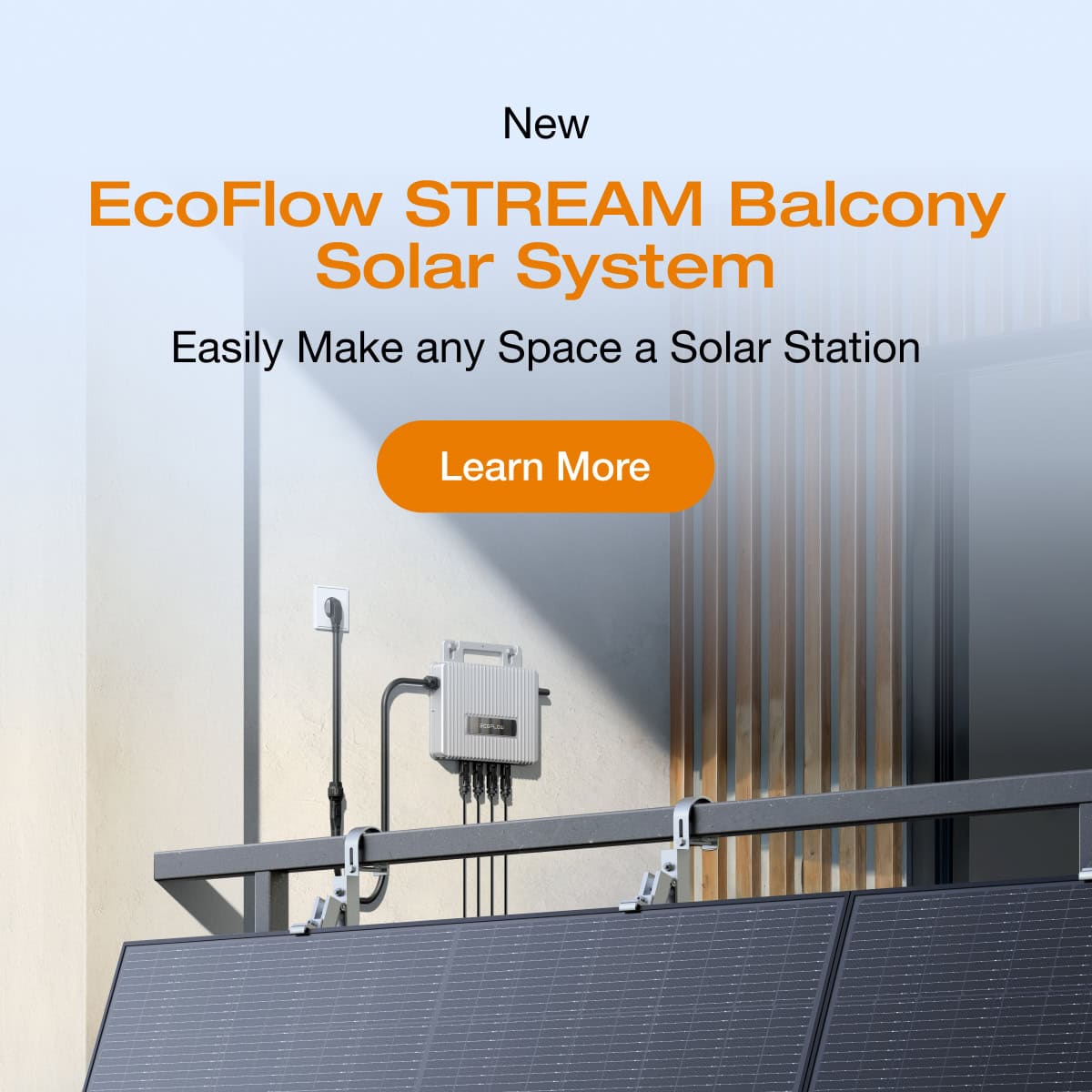Table of Contents
Embarking on a DIY solar panel installation can be rewarding, offering significant cost savings and a better understanding of your home’s energy systems. We’ll help guide you to simplify the process, from initial planning and preparation to the final steps of connecting your system to the grid.
Whether you’re a seasoned DIY enthusiast or new to the world of solar energy, we’ll provide the essential insights and step-by-step instructions needed to harness the sun’s power successfully. Prepare to discover the benefits, navigate the challenges, and begin your solar journey with confidence.
Can I Install My Own Solar Panel System?
Beginning a DIY project with solar panels like EcoFlow Solar Panels marks a significant step towards securing renewable energy for your home. To install your own solar panel system, you must first understand such a project’s legal and practical aspects.
The process begins with thorough planning, from evaluating your home’s compatibility for solar panel installation to understanding the technical intricacies involved with your specific situation. Ensuring your solar panel system aligns with UK regulations and safety standards is essential. With diligent preparation, installing solar panels yourself can be a rewarding experience that benefits both your household and the environment.
Do I Need Permission to Install Solar Panels on My Roof?
When considering the installation of solar panels on your roof, it’s critical to understand if you need permission. In the UK, solar panel installations often fall under “Permitted Development,” meaning you typically won’t need planning permission. However, there are exceptions, mainly if your property is a listed building, in a conservation area, or if the installation could significantly impact the building’s external appearance.
Solar panels should not protrude more than 200mm above the roof’s surface, and you mustn’t negatively affect the character of your area and home. Ensuring the installation does not obstruct or overshadow neighbouring properties is also important. For homes in designated areas, like Areas of Outstanding Beauty or World Heritage Sites, additional permissions may be required to preserve the visual integrity of the home’s surroundings.
Before proceeding with any installation, checking with your local planning authority to confirm specific requirements or restrictions is prudent. They can provide guidance tailored to your situation, helping you navigate the process smoothly. Ensuring compliance with these regulations from the outset can save you time and potential legal complications, facilitating a hassle-free installation of your solar panels.
DIY Solar Panel Installations & UK Building Regulations
Navigating the UK Building Regulations is critical to DIY solar panel installations, ensuring safety, durability, and compliance. These regulations cover several key areas, including structural integrity, electrical safety, fire risk, and energy efficiency.
Your roof must be evaluated for its ability to support the additional weight of solar panels, which may require consultation with a structural engineer for older or compromised structures. Electrical installations must adhere to Part P of the Building Regulations, highlighting the importance of professional involvement for safely connecting your system to the home’s electrical grid.
Fire safety considerations are also crucial, with specific attention to the installation’s potential impact on fire spread across the roof. Additionally, the overall energy efficiency of your home should not be adversely affected by the installation, ensuring that the solar panel system contributes positively to your property’s energy performance.
Compliance with these regulations safeguards your installation and optimises its performance and longevity, making professional advice or consultation a valuable part of the DIY process.
What’s Required to Mount Solar Panels?
Setting up a solar panel system requires more than just a can-do attitude; it demands a clear understanding of the tools and materials necessary for a successful project. Mounting solar panels on your home is a meticulous process that involves precision, safety, and the right equipment.
Tools
For a stress-free installation, having the proper arsenal of tools is vital, especially if you’d like to build any custom features or additions. You should have a cordless drill within your toolkit to attach solar panel mounts securely to your roof. An impact driver helps by delivering the torque necessary for driving screws firmly, ensuring the panels remain steadfast. Socket toolsets allow you to tighten all nuts and bolts, securing panels against the elements.
The installation’s electrical stages require wire strippers and crimpers for accurate wiring preparation and connection. A multimeter is essential here, testing the system’s electrical output and ensuring the integrity of the connection. Due to the elevated risk of the task, you should prioritise safety with equipment like a sturdy ladder, safety harness, gloves, and protective eyewear.
Tools for precision, such as a spirit-level and tape measure, ensure panels are optimally aligned and spaced to capture the most sunlight. A sealant gun with robust roofing sealant is necessary to waterproof the surface and seal any penetrations. At the same time, an angle finder aids in setting your panels at the ideal tilt, enhancing efficiency based on your location. These tools are also valuable for future home improvement efforts and system maintenance, making it all the wiser to familiarise yourself with their safe and effective use for a high-quality installation.
Materials
For DIY solar panel installations, selecting the most suitable materials is just as important as having the proper tools, and the centre of your project will be the solar panels themselves. For those with more demanding energy requirements but limited space, the EcoFlow Rigid Solar Panels are an excellent choice, known for their high efficiency and ergonomic design. Alongside the panels, you’ll need a reliable mounting system, including brackets and rails, designed to attach panels to your roof securely.
Wiring and connectors are essential for linking your panels to your home’s power system, with high-quality solar cables and weatherproof connectors ensuring a seamless and durable connection. Additionally, waterproof flashing and sealants are essential for protecting your installation from the elements and preserving the integrity of your roof. Lastly, an inverter is needed to convert solar energy into electricity and is a pivotal component of your materials list. When chosen carefully, these materials form a robust backbone of a DIY solar installation, setting the stage for a successful energy transition.
The DIY Solar Panel Installation Process
- Plan and Prepare
Kicking off your DIY solar panel installation begins with detailed planning and preparation. Calculate your home’s energy needs to identify the required size and number of panels. Assess your roof for suitability – orientation, shading, and structural integrity are all key factors.
Become familiar with local codes and secure any necessary permits. Choose suitable panels and mounting systems for your project, and organise your workspace for safe and efficient access to your roof.
- Attach the Fixing Bracket to the Solar Panel
The first hands-on step is attaching the fixing bracket to your solar panels. These brackets help securely attach your panels to the roof, ensuring they can withstand varying weather conditions. Align the brackets with the panels’ mounting holes using the correct screws and tools for a firm attachment. Double-check each bracket for stability, laying the groundwork for a sturdy installation.
- Install Mounting System on the Roof
Next, install the mounting system on your roof, which usually includes rails to support the solar panels. Position these rails carefully, aligning them with your roof’s structural supports for a secure fit. Drill the mounts into place, applying sealant to prevent leaks. Proper spacing and alignment are vital for optimal energy production and sun exposure.
- Secure Solar Panels to Mounting System
With the mounting system in place, it’s time to secure the solar panels, such as our EcoFlow 400W Rigid Solar Panels, known for their high power output and durable construction. Lift and position each panel on the mounting rails according to your layout, then attach the panels using the previously installed brackets, ensuring each one is firmly secured. A slight gap between panels is essential for ventilation and preventing overheating, contributing to the system’s long-term performance.
- Connect the Solar Panels
After securing the panels, wire them together to form a cohesive system. Connect the panels‘ positive and negative wires, paying close attention to polarity to ensure proper electrical flow. Weatherproof connectors are crucial for protecting against environmental elements.
This step may involve configuring the panels in series or parallel, depending on your system’s requirements, to maximise efficiency and ensure a reliable electricity supply to your home. Follow the manufacturer’s guidelines closely to prevent electrical issues.
What Are the Benefits of DIY Solar Panel Installation?
Cost Savings
One of the most compelling benefits of DIY solar panel installation is the significant cost savings. You can save thousands on professional installer fees by conducting the labour yourself. This reduction in upfront costs makes solar power more accessible and can increase the overall return on your investment as the savings on your energy bills accumulate.
Learning and Skill Development
Embarking on a DIY solar panel installation offers a valuable learning experience, allowing homeowners to gain in-depth knowledge of solar energy systems. This hands-on project enhances your technical skills, from electrical wiring to understanding energy efficiency. Such skills are rewarding and practical, equipping you with the ability to perform future maintenance or expansions of your solar power system.
Customisation
DIY installations allow you to customise your solar panel system to match your home’s energy needs and roof layout (or perhaps even a balcony). Some professional installations may offer limited options, while a DIY approach allows for optimising panel placement, choosing specific components, and tailoring the system for maximum efficiency. This level of customisation ensures you get the most out of your solar investment.
Satisfaction and Independence
There’s a profound sense of satisfaction and independence that comes from installing your solar panels. Completing the project provides a tangible result of your effort, contributing to a sustainable future. This empowerment extends beyond the installation as you become more self-reliant in managing and understanding your home’s energy production, reducing your dependency on utility companies.
Environmental Impact
DIY solar panel installation directly contributes to reducing your carbon footprint. You’re actively combating climate change and promoting environmental sustainability by harnessing renewable energy. This benefit extends beyond individual savings, contributing to the global effort to shift towards cleaner energy sources, making a positive impact on the planet for the future.
What Are the Drawbacks of DIY Solar Panel Installation?
Potential for Mistakes
One of the primary drawbacks of DIY solar panel installation is the potential for mistakes. Without professional expertise, installation errors are more likely to occur, leading to inefficient energy production or damage to your home. Incorrectly installed panels can result in poor alignment with the sun, inadequate sealing against weather elements, or unsafe electrical connections, all of which could compromise the system’s performance and longevity.
Lack of Warranty and Support
Professional installations often come with warranties and ongoing support for the solar panel system. Homeowners may forfeit these benefits by choosing the DIY route, facing the risk of no coverage for parts or labour should something go wrong. Manufacturers may also limit warranty coverage if the installation isn’t performed by a certified professional, leaving homeowners to bear any repair or replacement costs entirely themselves.
Compliance and Safety Concerns
DIY installations pose significant compliance and safety risks. Navigating building codes, electrical regulations, and safety standards requires expertise. Without this knowledge, there’s a risk of failing inspections, violating local regulations, or creating electrical hazards.
These issues can lead to fines, mandatory corrections, or even injury, overshadowing the initial appeal of saving money through a DIY approach. Ensuring a safe, compliant installation often necessitates consultations with professionals, which can diminish the cost-saving advantages of DIY solar projects.
Frequently Asked Questions
It’s possible to DIY solar panels with the right tools, materials, and a comprehensive understanding of the installation process. However, while homeowners can successfully set up their own solar panel systems, adhering to local building codes and safety standards is crucial to ensure a successful installation.
DIY solar panel installations can be more cost-effective than professional setups because you save on labour costs. However, the total cost advantage depends on your ability to source materials affordably and complete the installation correctly. Mistakes or inefficiencies can offset initial savings, so careful planning and execution are vital.
Final Thoughts
Performing your own DIY solar panel installation is an empowering step towards energy independence and sustainability. Throughout our guide, we’ve explored the essentials of planning, the importance of choosing the right tools and materials, and the detailed steps to install your system safely.
While DIY projects come with challenges, the rewards of cost savings and personal satisfaction are significant. So, are you ready to start your solar adventure with high-quality, reliable panels? Explore our collection of solar panels to find the perfect fit for your home.







